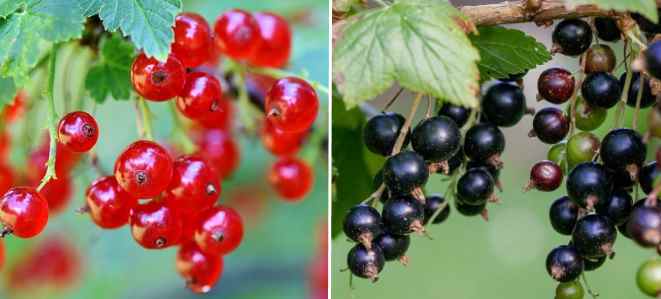58 Types of Berries: List of Berries With Their Picture and Name (Identification Guide)

There are many types of berries which are extremely tasty and have many uses. Many berry varieties are rich in vitamins, minerals, antioxidants, and other nutrients. Some of the healthiest types of berries are blueberries, raspberries, and blackberries. There are also some exotic types of berries such as goji and acai berries that are praised for their health benefits.
What Fruits Are Berries?
In botanical terms, a true berry is defined as a simple fruit developed from a single ovary of a single flower, containing one or more seeds embedded in a fleshy pulp. This strict botanical classification includes fruits that might surprise us, such as grapes, tomatoes, cucumbers, and even bananas. These fruits all come from flowers with a single ovary and have their seeds enclosed within a fleshy body, making them true berries by scientific standards. (1)
However, in the culinary world, the term “berry” is used more loosely to describe any small, juicy, and often sweet fruit, regardless of its botanical structure. This includes fruits like strawberries, raspberries, and blackberries, which are not true berries in the botanical sense. For example:
Strawberries are considered aggregate fruits because they form from a flower that has multiple ovaries, each developing into a small fruit (the tiny “seeds” on the strawberry’s surface) that are embedded in a fleshy receptacle.
Raspberries and Blackberries are classified as aggregate fruits as well, composed of many tiny drupelets clustered together, each drupelet being a fruit from its own ovary in a single flower.
This distinction highlights the fascinating way in which scientific classification sometimes diverges from common usage, reflecting not only the physical characteristics of these fruits but also the cultural and culinary roles they play in our diets.
Types of Berries (With Picture and Common Name) – Identification Guide
Let’s look in more detail at some of the most popular types of berries you should try to include in your diet.
Cranberries (Vaccinium macrocarpon)

Cranberries are a sour-tasting type of red berry that are rich in vitamin C and are packed with fiber and antioxidants.
In the wild, cranberries grow on vines near ground level in bogs. Cranberry fruits are used to produce juice, jams, and are also sold as dried berries. Because cranberries have a very tart taste, cranberry products often contain added sugar.
Being a red berry, cranberries are rich in antioxidants such as flavanones, anthocyanins, and flavanols.
One of the most common uses of consuming cranberry juice is to help prevent urinary tract infections. It seems that cranberries have a mild antibacterial effect and may help to address issues with the urinary system. (2)
Blueberry (Vaccinium corymbosum)

Blueberries are usually top on the list of dark-colored berries because of their juicy flesh and sweet taste.
As with most dark berries such as blackberries, blueberries contain a lot of vitamins and antioxidants. Studies have shown that anthocyanins (the pigment that gives berries its color) in blueberries help promote good eye health. Blueberries are also low in fat and high in fiber as well as vitamins C and K. (3)
Studies have also shown that dark berry fruits such as blueberries and blackberries have a good effect on cardiovascular health. One of the reasons why eating blueberries is good for you is that they help lower cholesterol. (4)
Huckleberry (Vaccinium ovatum)

You could easily mistake huckleberries for blueberries as they look very similar. In fact, in some countries, they are called the European blueberry and are also referred to as bilberries.
Huckleberries are a type of wild berry that is rarely cultivated.
The notable difference between blueberries and huckleberries is the seeds. Compared to blueberries, huckleberries also have less sugar and, therefore, fewer carbs. However, just like most types of dark berries, huckleberries are rich in fiber and antioxidants. (5)
You can use huckleberries in your diet in place of blueberries if you are looking to reduce your carb intake.
Chokeberries (Aronia)

Chokeberry (Aronia berry) is a type of sour berry that looks similar to blueberries but has a darker, almost black color.
The reason why chokeberries are one of the bitter-tasting berries is due to their high levels of tannins. Eating a few of these dark types of berries can leave your mouth feeling dry and bitter.
Because of their astringent taste, most people don’t eat fresh chokeberries. Rather, they use them to make jams, teas, syrups or put into baked goods.
Although chokeberries are a type of black-colored berry, you can also get red chokeberries.
According to some studies, chokeberries could be one of the healthiest berries for improving cardiovascular health. The antioxidants in these dark berries help reduce inflammation, blood pressure, and cholesterol. (6)
If you find chokeberries too bitter to eat, then you can buy chokeberry extracts in the form of powder.
Elderberry (Sambucus)

Elderberry is another berry on the list of dark berries that are healthy for you. However, unlike many of the other healthy berries, these tiny black fruits shouldn’t be eaten raw.
Elderberries may be among some of the healthiest berries to consume. Elderberries are rich in vitamins C and A and are a good source of healthy minerals. (7)
To incorporate these small dark berries into your diet, you can make elderberry tea or syrup. In fact, there is some evidence that elderberry syrup can help treat colds and other upper respiratory infections. (8)
Similar to the health benefits of other dark berries, the anthocyanins in elderberry are good for your heart health and can help boost your immune system. (9, 10)
Gooseberry (Ribes uva-crispa)

Gooseberries are a type of sour berry that grows on small bushes and are usually a green type of berry.
Even though gooseberries may be among the sourest berries you can eat, they are still not as sharp and tangy as lemons. There are also varieties of gooseberry bushes that produce red, purple, yellow, and white berry fruits.
Some types of gooseberry (botanically a currant) have been crossed with black currants to produce a dark berry called jostaberries.
As with most edible berries, gooseberries contain fiber, vitamins, and other nutrients. Various gooseberry cultivars are also a good source of antioxidants, although darker varieties of gooseberries typically have higher levels of anthocyanins. (11)
Lingonberry (Vaccinium vitis-idaea)

Another type of red berry is the lingonberry which has a bitter taste and grows on small bushes.
Because of their tart taste, these small red berries are often used to make jams, syrups, compotes, or added to smoothies. Their rich vitamin C content and trace minerals can help to improve the nutritional content of many foods. (12)
To enjoy its health benefits, you should consume fresh lingonberries rather than powdered supplements. Studies have shown that the fiber content in lingonberries helps prevent blood sugar spikes. However, lingonberry supplements didn’t have the same positive effect. (12)
Boysenberries (Rubus ursinus x idaeus)
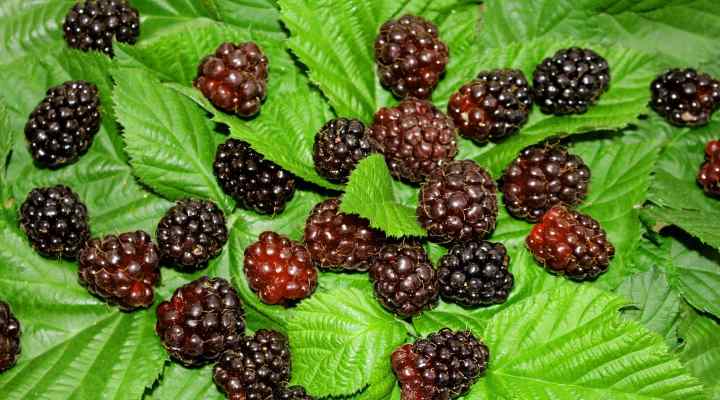
A hybrid berry called the boysenberry is a cross between a loganberry, blackberry, raspberry, and dewberry.
Boysenberries are a type of dark red or maroon berry that looks similar in shape to a blackberry. Although these red berry fruits don’t have as many vitamins as blackberries, they have just as much fiber. Boysenberries also contain many important nutrients, vitamins and minerals. (13)
Studies indicate that eating these soft juicy red berries may help to lower blood pressure and help prevent fat absorption in the gastrointestinal tract. (14, 15)
Red Currants and Black Currants (Ribes rubrum and Ribes nigrum)
Red currants are a type of vibrant red berry which grows in clusters like grapes.
Redcurrants are similar in size to blueberries and these shiny red berries have a tart, tangy taste that still has some sweetness. The astringent taste of these currant varieties can leave your mouth feeling somewhat dry, although not as dry and bitter as chokeberries.
Being a good source of antioxidants, red currants are extremely good for your health. However, studies have shown that black currants contain significantly higher levels of anthocyanins than redcurrants. (16)
Delicious Fruits We Think of as Berries
Let’s look in more detail at some delicious small soft fruits that we use as berries in the culinary world, but are actually not true berries botanically. These berry-type fruits are called aggregate fruits because they grow from a single flower when several ovaries merge together.
Strawberries (Fragaria × ananassa)
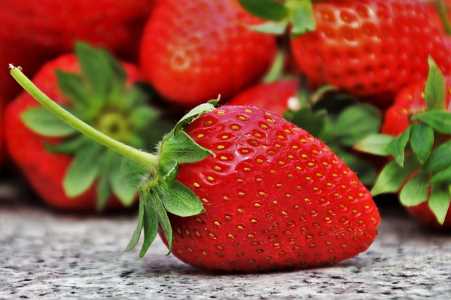
Fresh varieties of strawberries are some of the most popular types of summer fruits in the world. Strawberries are fast growing fruit that can also grow to become some of the largest types of berries you can buy.
Strawberries are an aggregate fruit that are usually red in color. However, there is a type of white strawberry called a pineberry that you can read about later in the article.
Most of the benefits of eating red fruits such as strawberries come from the high levels of vitamin C. For example, 5 medium-sized strawberries can provide you with 60% of your vitamin C daily requirements. (17)
Strawberries are delicious berry fruits to eat whole as a dessert. They are also delicious berries to put in smoothies, make into jam, or just blend and pour over desserts.
Although not classed as a type of true berry, some people put strawberries on the list of superfoods. Eating strawberries is good for lowering inflammation, blood pressure, and improving cardiovascular health. (18, 19)
Blackberry (Rubus fruticosus)
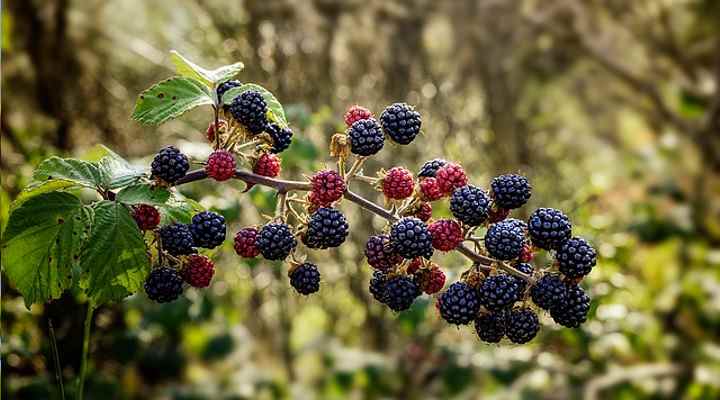
Although not a true berry, for many people blackberries are one of the tastiest berry fruits that they can eat.
What is it that makes this dark-purple berry a super fruit? Similar to blueberries, blackberries are an amazing source of healthy antioxidants and vitamins. Blackberries contain a number of phenolic compounds and are rich in fiber and vitamin C. (20)
The best blackberries to eat are ones you pick in the wild. As with most black and purple berries, eating blackberries has a positive impact on your cardiovascular health. In fact, compared to berries such as blueberries, cranberries, and red raspberries, blackberries are one of the healthiest berries you can eat. (21, 22)
Red, Black, Golden and White Raspberry (Rubus spp.)
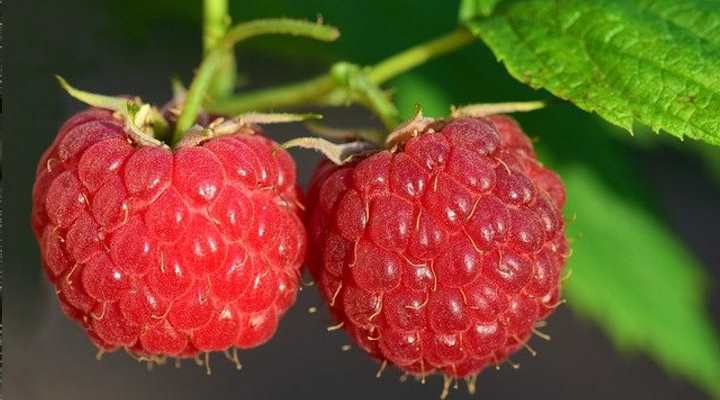
Raspberries are another berry-type of fruit that many people class as a super fruit with amazing health benefits.
Red raspberries are popular summer berries that are packed full of vitamin C. In fact, of all the fruits on the list of healthy berries, raspberries come out top in terms of dietary fiber. (23)
Consuming red raspberries has been linked to reducing the risk of developing chronic diseases such as cancer, heart disease, and type 2 diabetes. (23) You can find more details in my article about the scientifically proven health benefits of raspberries.
Did you know that there are other types of raspberries which may be even healthier for you than the red varieties?
Black raspberries (Rubus occidentalis)

Black raspberries may look like blackberries but they are in fact a black variety of raspberry. As you would expect from a black type of berry, they are rich in anthocyanins. Studies have shown that black raspberry varieties are good for lowering inflammation and cholesterol. They have even been linked to cancer prevention. (24, 25)
Golden raspberries (Rubus ellipticus)
Golden raspberries are an unusual type of golden berry with many health benefits. Scientists describe this kind of raspberry as a yellow raspberry with “super antioxidant” activities. (26)
White raspberries (Rubus idaeus ‘Anne’, ‘All Gold’ and ‘Fallgold’)
One rare type of raspberry is a variety of white raspberry. Although technically there isn’t a botanical variety of raspberry that is completely white, some yellow raspberry varieties may be so pale that they appear almost white.
Olallieberry
A hybrid fruit called an olallieberry is a dark type of berry that looks like a plump blackberry or black raspberry.
Being a variety of black berry-like fruit, olallieberries probably are high in anthocyanins. However, there is no information on its nutritional content.
Mulberry (Morus)

Mulberries are berry-like fruits that look like long raspberries or blackberries and come in a variety of colors. Mulberry varieties come in black, purple, red, and even white types of berries.
Mulberries are a fairly sweet berry-type fruit that have a slightly astringent and tart taste. You can eat mulberries fresh, or you can use them in recipes as you would use blackberries or raspberries.
Because mulberries are very fragile summer fruits, it is difficult to buy them fresh. You can buy these types of berries frozen or you can grow a mulberry tree in your garden.
The healthy nutrients in these berry fruits have been linked to improving cardiovascular health, helping to manage type 2 diabetes, and helping to prevent obesity. (27)
Serviceberry (Juneberry)
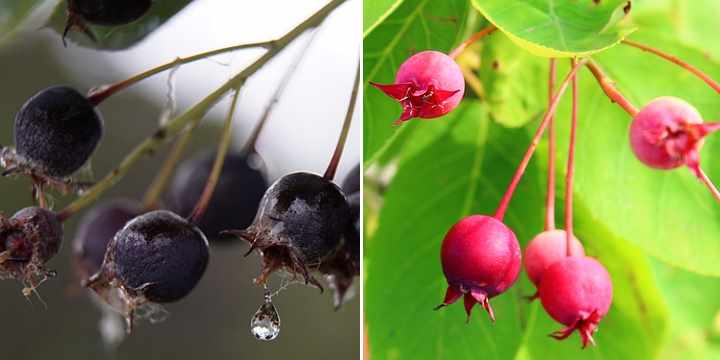
Serviceberry fruit. Left picture: mature purple serviceberry fruits. Right picture: immature red serviceberry fruits.
Serviceberries are types of berries that look like blueberries and have a purple color when mature. Botanically, serviceberries are pome fruits of the serviceberry trees and shrubs (Amelanchier).
Serviceberries are berry-type fruit that taste like sweet blueberries and are a popular ingredient for jams and jellies.
Serviceberries are also called juneberries because some of these berries ripen in June.
Types of Exotic Berries
Let’s look at varieties of exotic berries, many of which are rightly on the list of berries that are classed as superfoods.
Açai Berries (Euterpe oleracea)

Açai berries are small black-purple berries that look like grapes and grow on the açai palm tree.
Although it is difficult to buy these super berries fresh, açai berries are becoming more popular due to their fantastic health benefits. One of the most common ways of benefiting from this dark berry is to buy it in powder form.
Studies have shown that açai black berry powder has very high levels of polyphenols and other antioxidants. (28)
Goji Berries (Lycium barbarum or Lycium chinense)

Goji berries (wolfberries) are a red type of exotic berry that are better known in Western countries than açai berries.
Goji berries are among the types of berries that are classed as superfoods. It is difficult to buy fresh goji berries and they are usually sold as red dried berries. Just an ounce (28 g) of these super berries gives you half of your daily vitamin A needs and 10% of your fiber requirements. (29)
Because goji berries are usually sold dried, they have a very sweet taste with a slight bitterness. Some people use goji berries in baked goods to cut down on sugar and increase nutritional value.
Researchers have found that the high levels of antioxidants, such as in goji berries, can help to slow down aging, boost immunity, and improve blood health. (30)
Cape Gooseberry (Physalis peruviana)

Physalis is an orange type of berry that belongs to fruits in the nightshade family. Physalis berries are also called groundcherries, golden berries, or Cape gooseberries.
Physalis berries are low in fat and high in fiber. The health benefits of these golden berries are quite impressive due to their antioxidant content. They can help to reduce inflammation, strengthen your immune system, and they have nutrients that are good for vision. (31, 32, 33)
These orange berry fruits have a sweet taste that some people say is similar to tropical fruits such as mangoes or pineapples. You can eat these orange berries raw or you can chop them up in a smoothie or add to a savory salad for some sweetness.
Unusual Types of Berries You Can Eat
Apart from typical berries such as blueberries, cranberries, and redcurrants, there are some unusual varieties of berries that are definitely worth trying.
Cloudberries (Rubus chamaemorus)
Cloudberries are winter berries that look like tiny orange raspberries and have a sharp, tart taste. Some say that cloudberries taste like a cross between redcurrants and red raspberries.
It is quite rare to find these healthy golden berries for sale in many countries. However, these are highly nutritional berries that are enjoyed by Scandinavians, where the berries grow naturally.
Interestingly, compared to other berries, cloudberries are a good source of plant protein. (34)
The goodness in cloudberries comes from the rich antioxidant content in the form of vitamin A, citric acid, and anthocyanins. (35)
Pineberries (Fragaria chiloensis x virginiana)

Pineberries are an unusual type of berry because they look like a white strawberry but taste like a pineapple.
Pineberries look stunning with their pale white flesh and bright red seeds. This white berry fruit is also very good for you. They have a similar fiber content to strawberries and contain trace amounts of vitamins and minerals.
If you want to try these “albino strawberry” fruits, you can learn how to grow your own pineberries in containers or your garden.
Salmonberry (Rubus spectabilis)

Salmonberries are a bright golden or orange type of berry fruit that looks like an orange raspberry.
Despite their unusual appearance, salmonberries are very good for your health. As with all berries, salmonberries are low in calories and fat but high in fiber and vitamins.
Adding salmonberries to desserts creates a splash or orange or reddish-orange color depending on their ripeness. These orange berries also taste sweet and have a very juicy flesh.
Learn about many types of red berries that grow on trees or shrubs (inducing identification guide and pictures).
Sumac Berries (Rhus aromatica)

Sumac trees (genus Rhus) are known for their bright red, berry-like drupes that grow in large cone-like clusters. Although they look like berries, sumac fruits are drupes—fruits with a seed in the middle like a peach or apricot. Each small sumac berry measures 0.16” (4 mm) across.
The sumac berries have characteristic fine hairs, giving the red drupe a fuzzy appearance. The clusters of crimson-red sumac fruits grow up to 12” (30 cm) long.
The red sumac drupes have a citrusy flavor with a distinct tangy taste and are high in vitamin C. Sumac berries are also used to create sumac spice, popular in Middle Eastern cuisine.

The red sumac spice is mainly cultivated from the Syrian sumac (Rhus coriaria) and is commonly used in Middle Eastern cuisine and other spice mixtures such as za’atar (left)
Hackberry (Celtis occidentalis)

Hackberry fruit is a small round berry-like drupe that grows on hackberry trees (Celtis) and has a sweet taste. The tasty edible drupes grow as globular green fruits that mature to red and then a deep purple color. The fruit dangles on short stems. Hackberry fruit is ready for eating in September, and the berries persist on the tree throughout winter.
The sweet drupes are popular with birds and humans alike, and you can eat them raw or use them to make delicious jelly.
Other Types of Berries
Acerola Berry (Barbados cherries) (Malpighia emarginata)

Acerola berries are small red stone fruits that grow on shrubs or small trees. The bright red round berries are distinguished by three triangular seeds inside. The globose fruits grow in groups of two or three. They measure 0.4” to 1.18” (1 – 3 cm) in diameter.
Also called Barbados cherries, the berry-like red fruits are the size of a cherry. They have a sweet and tart flavor, with a taste like a blend of cherry, apple, and citrus. Common uses for the edible berries include making desserts, juices, jams, and jellies.
Acerola berries are extremely high in vitamin C. According to studies, they are one of the richest natural sources of vitamin C in the world. Due to their rich nutrient and antioxidant content, they are considered to be a superfood.
Bilberry (Vaccinium myrtillus)

Known as the European blueberry, the blue berries are small, round fruits with flattened ends growing on small deciduous shrubs. The bilberry shrub grows up to 18” (45 cm) tall and features small, oval, green leaves that turn reddish in the fall. Bilberry shrubs also produce small, urn-shaped pink flowers.
The bilberry bush is native to Europe and is commonly found growing in forests and meadows. The small bluish-black berries measure 0.4” (1 cm) in diameter. They have thin skin covering juicy dark-colored flesh. Bilberries are known for their sweet taste, which goes well in jams and pies and can be eaten raw.
Bilberry plants are typically grown in acidic, well-draining soils in partial shade to full sun. The low-maintenance shrubs tolerate cold temperatures and thrive in boggy soils, open forests, and parklands.
Crowberry (Empetrum nigrum)

Crowberry is a fruit-producing evergreen shrub with small purplish-black drupes. The berry-like stone fruits measure 0.25” (6 mm) and grow in dense clusters on the low-growing, spreading shrub. The shrub also has narrow, needle-like dark green leaves that create a dense, carpet-like mat and grows up to 1.8 ft. (0.5 m) tall.
The edible black crowberries have an acidic taste when consumed raw. Typically, the fruit is dried before making jams, jellies, and baked goods. The small black berries are also a valuable food source for birds and other wildlife.
Black crowberry shrubs also have ornamental value in garden landscapes. The prostrate shrub has a spreading habit through underground stems. This makes it ideal for evergreen ground cover, borders, or planting in rock gardens. It’s also tolerant of salt spray, making it suitable for coastal landscapes.
Dewberry (Rubus caesius)

Dewberry is a trailing, thorny perennial shrub that produces delicious blackberries and attractive white flowers. The black berry-like fruits are a cluster of aggregate drupelets with a bluish-waxy coating. These grow on prickly stems and are preceded by clusters of five-petalled white flowers 1” (2.5 cm) in diameter.
Dewberry shrubs grow 6.7 ft. (2 m) and are characterized by slender, arching, spine-covered stems. The black berries have juicy flesh and a sweet yet tart flavor reminiscent of blackberries. The edible berries are also a great food source for songbirds and small mammals in the fall.
Also called European dewberry, the shrubs are a cross between raspberries and blackberries. Various hybrids have also been developed, most notably youngberries.
Youngberry (Rubus caesius ‘Youngberry’)

Youngberry is a thorny, deciduous shrub producing dark red to black raspberry-like fruits. The oval to conical-shaped red fruits have a sweet flavor without the tartness of blackberries. The vigorous shrub grows up to 5 ft. (1.5 m) tall and thrives in full sun.
The shrub’s berries grow on arching, thorny canes. These blossom in spring with white flowers followed by dark, plumpish fruits ready for harvesting in late summer and early fall. In addition to producing fruit, youngberry shrubs are ideal for growing as a security hedge or privacy barrier.
Youngberry is known for its disease resistance and is a popular choice for home gardeners looking to grow their own berries. Thornless varieties are also available to make harvesting the juicy fruits easier.
Juniper Berry (Juniperus communis)

The female juniper plants produce colorful berries, which are actually modified cones
Juniper berry is the fruit of a small evergreen coniferous shrub or tree in the family Cupressaceae. The blue or purple fruits are berry-like fleshy cones called arils. The bluish-black flesh surrounds small seeds. The berry-like seeds emerge green and mature to purple-black. They measure 0.125” to 0.5” (3 to 13 mm).
The common juniper shrub or tree features dark green scale-like leaves and can grow up to 33 ft. (10 m). However, there are cultivars that can grow as a small creeping shrub that spreads up to 12 ft. (3.6 m), producing black, waxy, fleshy cones in garden landscapes.
The most common use for juniper berries is to flavor gin. In some cuisines, the tasty berries are used as a spice. They have a sharp, distinct flavor that compliments meat and game dishes. Despite being an edible berry, some species of juniper berries are too bitter to eat.
Kiwi Berries (Actinidia arguta)

Kiwi berries are green or reddish fruits like small plums or grapes. The oval fruits grow on woody climbing vines. The green berries have smooth skin and look like traditional miniature kiwi fruit. Cutting the berries open reveals green flesh, black seeds, and a yellowish-green center.
Kiwi berry vines grow up to 30 ft. (9 m) tall in garden landscapes. They bloom in spring with white, cup-shaped flowers that emit sweet fragrances. After blooming, small oval berries appear and mature to around 3” (7.5 cm) long. The berry-producing vines are popular due to the sweet flavor of their fruits.
In addition to providing tasty kiwi berries, Actinidia arguta has tremendous ornamental value in landscapes. The vigorous vine can scramble over sturdy trellises, arbors, or pergolas in USDA hardiness zones 3 to 8. Additionally, you can train the twining vines to grow over a fence to create a hedge, privacy screen, or natural barrier.
Loganberry (Rubus × loganobaccus)

Loganberry is a deciduous hybrid berry plant that produces large, juicy, dark red berries on thornless canes. The juicy berry-like fruits are a cross between a blackberry and a raspberry. The berries measure 0.78” to 1.18” (2 to 3 cm) long and have a sweet taste without tartness.
Loganberry shrubs thrive in full sun and grow 5 ft. (1.5 m) tall and wide. The vigorous shrub blooms in spring with white flowers followed by deep red fruits that look like large blackberries. The flowers and fruits benefit wildlife gardens by attracting bees, pollinators, and birds.
Ripe loganberries are ready for harvesting in summer. The versatile berries are ideal for making sweet jams, pies, desserts, and beverages. They are also rich in antioxidants and vitamins, making them a healthy addition to any diet. Like most fruits from shrubs in the genus Rubus, they are high in vitamin C.
Marionberry (Rubus × marion)

Marionberry is a hybrid blackberry that produces large, juicy, flavorful berries. Growing on thorny stems, the plump blackberry-like fruits ripen from green to red, then shiny, deep purple or black. Other features of the deciduous shrub are its vining canes, compound, triangular leaves with serrated margins, and white flowers.
Marionberry shrubs can grow up to 20 ft. (6 m) tall. However, in garden landscapes, they typically grow 4 ft. (1.2 m) tall and 6 ft. (1.8 m) wide. The berry-like fruits are ready for harvesting in early to late summer. In gardens, you can prune the shrubby vines to grow on trellises or fences.
Marionberries have a sweet-tart flavor and are delicious fresh off the shrub or used in jams, syrups, ice cream, pies, and other desserts. They have a high yield and resistance to diseases. This makes the berries ideal for growing in low-maintenance fruit gardens.
Tayberry (Rubus fruticosus x idaeus)

Tayberry is a hybrid shrub producing berries that are a cross between a blackberry and a red raspberry. This vigorous, thorny shrub produces delicious, reddish-purple cone-shaped berries with a sweet-tart taste. The conical fruits grow 1.5” (4 cm) long on spiny canes up to 7 ft. (2.1 m) long.
Tayberry shrubs thrive in full sun to partial shade and require well-draining soil. The red aggregate fruits are ready to harvest in mid-summer and are delicious straight off the plant. Compared to loganberries, they have a sweeter, less acidic taste. Culinary uses for the edible berries include jams, jellies, pies, and desserts.
Thimbleberry (Rubus parviflorus)
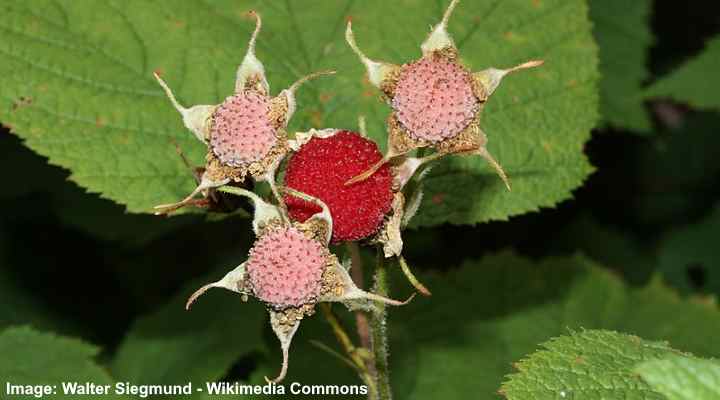
Thimbleberry is a deciduous shrub bearing vibrant red, round berries. Identifying features of the berry-producing shrub are its fragrant white flowers 2” (5 cm) in diameter, maple-like green leaves with toothed edges, and tasty red berries. Thimbleberry shrubs grow 4 to 8 ft. (1.2 – 2.4 m) tall and wide.
This thicket-forming thorny shrub’s edible red berries resemble thimbles, hence the name. It’s native to North America and thrives in moist, well-drained, organically rich soils. Its hardiness range is USDA zones 3 to 10. Landscaping uses for thimbleberries include informal hedges, foundation planting, soil erosion control, and protective barriers.
Japanese Wineberry (Rubus phoenicolasius)

Japanese wineberry is a prickly, deciduous shrub with unique red-purple stems and clusters of raspberry-like edible fruits. Features of this thorny shrub include bright green leaves with serrated heart-shaped leaflets, reddish stems, and white or red star-shaped flowers. The fruiting shrub grows up to 10 ft. (3 m) tall.
This type of Japanese raspberry shrub has roundish berry-like fruits measuring 0.4” (1 cm) in diameter on spiny stems. Native to East Asia, wineberries have vigorous growth and can become invasive. Apart from growing the shrub for its delicious berries, landscaping uses include an informal hedge or training it to grow against a fence, trellis, or wall.
The taste of Japanese wineberries is said to be like raspberries, with a sweet flavor. They taste best when freshly picked. Culinary uses for wineberries are similar to blackberries and raspberries.
Saskatoon Serviceberry (Amelanchier alnifolia)

Saskatoon serviceberry deciduous shrubs produce clusters of edible purple or dark blue berries. It has clusters of fragrant, white flowers in spring, attractive foliage, and orangey-red fall colors. Its delicious, sweet blue berries ripen in early summer. In winter, the multi-stemmed shrub has light gray bark featuring horizontal stripes.
The suckering Saskatoon serviceberry provides all-season interest in garden landscapes. You can grow the drought-tolerant shrub as foundation plantings, hedges, screens, or specimen plants. Its intertwining branching habit makes it a great windbreak or security barrier. The shrub grows 10 to 15 ft. (3 – 4.5 m) tall and wide.
Saskatoon serviceberry shrubs are hardy plants that withstand cold temperatures and various soil conditions. The sweet, juicy berries are ideal for eating fresh or using in jams, jellies, and pies. Additionally, the sweet fruits attract birds and other wildlife.
Nannyberry (Viburnum lentago)

Also called sheepberry, nannyberry is a deciduous shrub producing clusters of dangling dark blue or black berries. This multi-stemmed shrub features oval-shaped green leaves, flat-topped clusters of white flowers, shiny black berries, and stunning reddish-purple fall colors. Nannyberry shrubs can grow 10 to 20 ft. (3 – 6 m) tall and up to 12 ft. (3.6 m) wide.
White-flowering nannyberry shrubs thrive in full sun or part shade. Its upright, rounded shape with dense foliage and attractive berries make it popular in temperate climates. You can plant the shrub for hedging, screening, foundation planting, or as a specimen plant. It is suitable for USDA planting zones 2 to 8.
Nannyberries have a unique taste, described as sweet with hints of vanilla and spice. When fully ripe, they can be juicy and have a soft texture. However, when overripe, it looks like a wrinkled raisin with a bitter taste.
Bearberry (Arctostaphylos uva-ursi)

Arctostaphylos-uva-ursi berries
Bearberry—also called kinnikinnick—is a small, spreading evergreen shrub with bright red edible berries. Suitable as ground cover, barberry features a low-growth habit, whitish-pink urn-shaped flowers blooming in spring on red stems, and glossy red berries in the fall. The bushy, dense shrub grows 1 ft (0.3 m) tall and 6 ft. (1.8 m) wide.
An attractive feature of barberry shrubs is its small, leathery, dark green oval leaves. These turn purple or red in winter, adding to the ornamental value of the shrubs. Bearberry shrubs form a dense mat of foliage. Landscaping uses include shrub borders, year-long ground cover, and erosion control.
The round red fruit on barberry shrubs has a relatively bland, mealy taste. The best way to consume the berries is to cook them to bring out their natural sweetness. Popular culinary uses for the berries include preserves, jams, or adding to stews and sauces.
Seaberry (Sea Buckthorn) (Hippophae rhamnoides)

Seaberry—commonly called buckthorn—is a hardy, deciduous shrub producing clusters of bright orange berries. Identifying features of the flowering shrub are its narrow, blue-green needle-like leaves, small, inconspicuous green flowers, and masses or deep orange berries covering the stems. Seaberry shrubs grow 7 to 13 ft. (2 – 4 m) tall.
Seaberry shrubs are known for their ability to withstand harsh conditions. The hardy plants are tolerant of drought, sea spray, full sun, and saline soils.
Sea buckthorn orange berries are prized for their rich nutritional content. The fruits have one of the highest concentrations of vitamin C from all plant sources. They are also rich in carotenoids, vitamin K, and vitamin E.
Sea buckthorn berries have a sour, acidic taste resembling lemons. Common uses include making compotes, ice creams, jellies, or adding to salad dressings.
Ugni Fruit (Chilean Guava) (Ugni molinae)
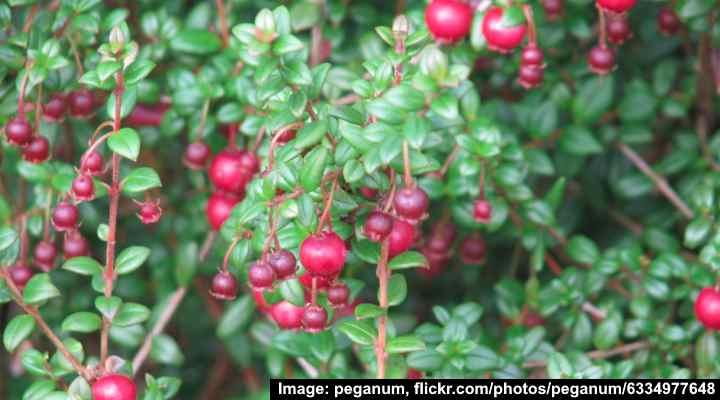
Ugni fruit is a small evergreen bushy shrub producing delicious round, dark red berries that ripen in late summer. The ornamental shrub blooms in spring with dangling clusters of pinkish-white bell-shaped flowers. It also has leathery, dark green leaves, creating lush, dense foliage. The sweet red berries taste like strawberries and passion fruit.
Also called Chilean guava, the decorative shrubs grow 3 to 6 ft. (0.9 – 1.8 m) tall and wide. Ideal for pollinator gardens, the fragrant spring flowers attract bees and butterflies to garden landscapes. This highly versatile shrub is ideal for a hedge, border plant, foundation planting, or container use.
In addition to being a beautiful and ornamental shrub, Ugni fruit is also valued for its edible berries. The berries have a sweet, slightly tangy taste that isn’t too tart.
Maqui or Chilean Wineberry (Aristotelia chilensis)

Chilean wineberry is a small evergreen tree producing small, purple-black berries. The edible shiny black berries measure 0.24” (6 mm) in diameter and taste like elderberries or blackberries. The attractive tree blooms with white flowers in spring. Its foliage is oval to lanceolate leaves with serrated edges growing on thin, flexible branches.
Also called maqui, this versatile tree grows 12 to 15 ft. (3.6 – 4.5 m) tall. The multi-stemmed tree has a wide-spreading, compact shape, making it an attractive addition to mid-sized gardens. It’s not frost tolerant and grows best in USDA zones 7 to 10. It thrives in full sun but can tolerate partial shade.
Maqui berries are prized for their taste and reported health benefits. In Chile, the berries are fermented and used to make wine. However, they also are a great addition to smoothies, desserts, jams, and juices. Reports suggest that they contain the highest antioxidant level of any fruit.
Oregon Grape (Mahonia aquifolium)

Oregon grape evergreen shrubs produce bunches of blue-black berries. Native to western North America, the bushy plant is identified by its holly-like dark green, glossy leaves with spiny margins, clusters of bright yellow flowers, and edible grape-like berries in late summer. The dark blue berries have a waxy appearance.
Oregon grape shrubs grow 3 to 6 ft. (0.9 to 1.8 meters) tall and up to 5 ft. (1.5 m) wide. The plant’s lustrous foliage emerges bronze-red in spring, turning rich burgundy in the fall. Additionally, the yellow flowers and dark blue fruit attract wildlife like pollinators, hummingbirds, and songbirds.
Landscaping uses for Oregon grape shrubs include a hedge, screen, and foundation planting in shade gardens. It also naturalizes well and can be planted in woodland or open areas. Its fruit is sweet and delicious straight off the tree and a popular ingredient in making jellies.
Yew Berry (Taxus baccata)

Yew berries are bright red fruits that grow on yew trees and shrubs. The berry-like fruits are fleshy seed-containing cones called arils. The scarlet-colored modified seed cones measure up to 0.25” (7 mm) in diameter. Other features of yew plants are their flat, dark green needle leaves 1.5” (4 cm) long.
It’s important to note that the only edible part of yew berries is the sweet-tasting, red fleshy cup-like structure. All other parts of yew shrubs, including the seeds, are highly toxic and should never be consumed.
Yew berry shrubs for landscaping grow 6 to 15 ft. (1.8 – 4.6 m) tall and have a dense, compact habit. The narrow, columnar Irish yew (Taxus baccata ‘Fastigiata’) is ideal for creating a vertical accent as it grows 30 ft. (9 m) tall and only 8 ft. (2.4 m) wide.
The shrub’s dark green foliage and bright red berries add a splash of color in the fall and winter.
Hawthorn Berry (Crataegus spp.)

Hawthorn berries are small red fruits growing in abundant clusters on thorny trees. The globose red berry-like pomes—called haws—can measure up to 1.6” (4 cm) long. Other characteristics of the shrubs are their branches covered with long thorns, small parsley-like lobed leaves with serrated margins, and star-shaped white to pink spring flowers.
Depending on the species, hawthorn shrubs or trees grow 15 to 40 ft. (4.5 – 12 m) tall. Thanks to the spiny branches, smaller cultivars are ideal for growing as an effective privacy hedge or barrier. The deciduous tree is covered in showy blooms in late spring. However, the flowers emit an unpleasant scent.
Hawthorn shrubs and trees are relatively low-maintenance and can tolerate a range of soil conditions, although they prefer well-draining soil. They thrive in full sun and are drought-tolerant in USDA zones 4 to 7.
Barberry (Berberis spp.)
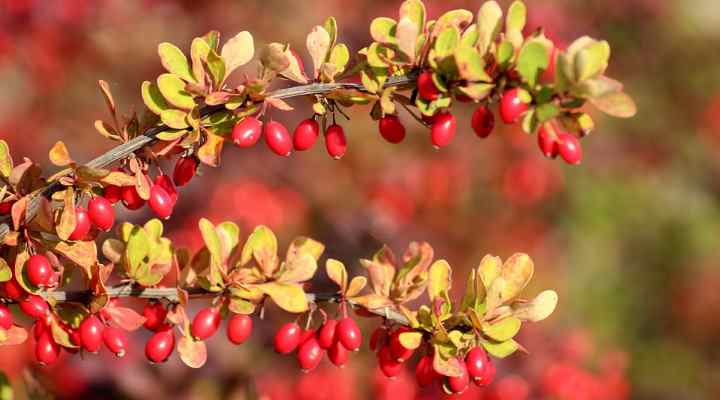
Barberry is a versatile shrub known for its small oval red or dark blue berries. This diverse group of shrubs is known for their thorny branches, luscious, shiny foliage, showy orange or yellow flower clusters, and bright red berries. The small berries measure 0.2” to 0.6” (5 – 15 mm) long.
This shrub comes in a variety of species, each offering unique characteristics. Some varieties have small, oval leaves 0.4” (1 cm) long. In contrast, other varieties have clusters of showy flowers and leaves measuring up to 4” (10 cm) long. Deciduous barberry shrubs have attractive red or pink fall colors.
Although barberry fruits are classified as edible, the fruit of some species contain potentially toxic compounds. However, the common barberry (Berberis vulgaris) has edible berries rich in vitamin C with a sharply acidic taste. Their high pectin content makes them ideal for jam-making.
Nanking Cherry (Prunus tomentosa)

Nanking cherries are tasty, scarlet fruits that appear on cherry shrubs in early to mid-summer. The deciduous shrubs grow up to 10 ft. (3 m) tall and bloom in early spring with masses of white cherry blossoms. The shrub’s foliage consists of dark green, ovate leaves with fuzzy undersides.
Bright red Nanking cherries have a refreshing, sweet, and slightly tart flavor. They measure 0.5” (13 mm) in diameter and attract birds and wildlife to gardens. The delicious cherries taste great from the shrub, or you can use them to make jams, jellies, and tarts.
Also called downy cherry or Shanghai cherry, the cherry shrubs are ideal for adding color to garden landscapes. They tolerate drought and heat and thrive in full sun to partial shade. Landscaping uses include shrub borders, windbreaks, flowering hedges, and a single specimen plant.
Pin Cherry (Prunus pensylvanica)

Pin cherry is a small deciduous tree or shrub producing showy red or burgundy berry-like drupes. The small edible fruits measure 0.25” (6 mm) and have a tart taste. The pin cherry tree has oblong leaves 3” to 5” (7.5 – 13 cm) long that turn stunning orange, burgundy, and red shades in the fall.
The most outstanding feature of pin cherry trees is their spring blossoms. The tree blooms with clusters of five-petalled white flowers, each with up to seven flowers per umbel. Apart from a spectacular floral display, the blossoms attract butterflies and pollinators. The cherry fruit trees are suitable for growing in landscapes in USDA zones 3 to 7.
Pin cherries are a valuable food source for birds and other wildlife. However, their sharp taste and small size mean they have limited culinary uses. However, you can pit the fruits and use them to make syrups, jellies, or jams.
Silver Buffaloberry (Shepherdia argentea)

Silver buffaloberry produces clusters of bright red, fleshy, berry-like drupes. The thorny, deciduous shrub has silver-gray scaly stems, slender elliptic silvery-green leaves, inconspicuous yellow flowers that bloom in the spring, and bright red pea-sized berries. Silver buffaloberry shrubs grow 8 to 12 ft. (2.4 – 3.6 m) tall.
Buffaloberry is a versatile shrub that thrives in cold, northern climates. Its dense growth makes it ideal for mass plantings to create privacy screens, hedges, or windbreaks. It also tolerates various soil types, including dry, sandy, and poor soils. It is drought-tolerant and can thrive in hot, arid climates. This shrub also tolerates salt spray, making it suitable for coastal regions.
Buffaloberry is often used in landscaping for its attractive berries and silver foliage. You can plant it as a shrub border, windbreak, or wildlife habitat plant. The thorny branches can also provide security and discourage unwanted visitors.
American Mountain Ash (Sorbus Americana)

American mountain ash is a densely branched deciduous shrub producing abundant clusters of bright red berries. The characteristics of the shrub or small tree are pinnately compound leaves, white flowers in spring, and pea-sized red berries that persist into winter. The shrub’s foliage in the fall turns orange, yellow, red, and reddish-purple shades.
Also called the rowan tree, the American mountain ash shrub grows 10 to 30 ft. (3 – 9 m) tall. It has slender branches forming an open, rounded crown. Its all-season appeal comes from the fact that the showy orange-red berries persist on the shrub through winter, adding a pop of color to barren landscapes.
Although American mountain ash berries are edible, they are not tasty. Fresh off the tree, they have a bitter taste, rich in tannins. However, you can prepare the berries by cooking them to make conserves, jams, and jellies and add to soups.
Bunchberry (Cornus canadensis)

Bunchberry is a low-growing, mat-forming plant that produces bright red berry-like fruits. The prostrate dogwood plant is ideal for white-flowering ground cover, with four-petalled white flowers, dark green, lanceolate leaves, and red fruits. In the fall, the deciduous perennial turns eye-catching wine-red or purple shades.
The ground cover bunchberry plant grows up to 9” (23 cm) tall and 12” (30 cm) wide. As a type of dogwood plant, bunchberry grows in cool, moist forests and bogs. Its clusters of white flowers add a splash of color to spring gardens, and the red berries brighten landscapes in the fall.
Bunchberry perennials perform well in shady gardens or naturalized areas. You can grow it as a ground cover or for underplanting shrubs and trees.
Bunchberries are slightly sweet and can be eaten raw or cooked, but because they are mealy, they are mainly used to make jams, pies, and other sweet desserts.
Strawberry Tree (Arbutus unedo)
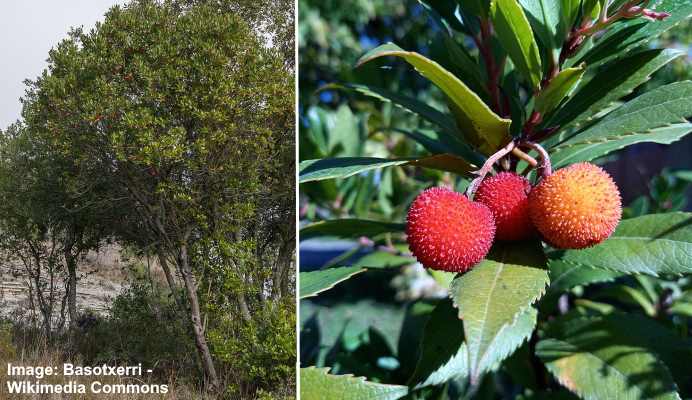
The strawberry tree has some of the most unusual berries from evergreen trees. The ornamental tree produces red fruits resembling strawberries. These reddish-orange fruits follow fragrant clusters of white, bell-shaped flowers. The round fruits measure 1” (2.5 cm) in diameter and dangle on long stems. After emerging, the berries gradually ripen to yellow or red.
The strawberry tree grows 6 to 15 ft. (1.8 – 4.5 m) tall and wide. It has multiple stems, giving it ornamental appeal as a small shrub. Landscaping uses for shrub-like trees are foundation planting, evergreen hedgerows, shrub borders, and container planting. Its tolerance for salty air makes it ideal for coastal landscapes.
In addition to its ornamental appeal, the strawberry tree is also known for its edible fruits. The fruits have a sweet but sometimes bland, mealy taste. It’s best to prepare the berries before consuming them. They work well in jams, marmalades, jellies, or sauces.
Rose Hip (Rosa)

Rose hips are the berry-like fruits from shrubs in the family Rosa. The showy edible fruits are typically red or orange and have a fleshy inside covering several hard seeds. Clusters of the oblong to round red “berries” grow on thorny branches and are ready to harvest in the fall after rose flowers bloom.
While they are not true berries by the strictest botanical definition, rose hips are commonly referred to as berries in everyday language due to their fleshy fruit-like appearance and are rich in vitamin C, making them valuable for culinary and medicinal uses.
Traditional uses for rose hips include making jams, jellies, syrups, tea, and beverages. For example, rosehip tea blended with hibiscus is a tasty caffeine-free drink. In some European countries, people use the berry-like fruits to make brandies, soups, or mead.
Rose hips also have potential health benefits. Research shows that the fruits are high in vitamin C and antioxidants. Traditionally, rosehip preparations have been used to boost the immune system and improve digestion.
Hobblebush (Viburnum lantanoides)

Hobblebush is a deciduous shrub renowned for its large, showy, lacy flowers and vibrant berries that ripen from red to purple-blue. Native to North America, the shrub features broad oval leaves with serrated edges, clusters of flat-topped white flowers, and red berries that turn bluish-black by fall.
The black or purple edible drupes have a taste like dates or raisins, and can be eaten raw or cooked. The bright white flowers resemble lacecap hydrangea flowers, contrasting with the lush foliage.
Hobblebush shrubs grow 3 to 10 ft. (0.9 – 3 m) tall and up to 12 ft. (3.6 m) wide. They form a dense, rounded shape and perform well in partial shade as a border plant, hedge, or specimen plant.
Agarita Berry (Mahonia trifoliolata)

Agarita berry is a thorny evergreen shrub producing bright red edible berries in late spring. The elliptical or oval red berries have a deliciously sweet, slightly tart taste. Other features of the fruit-producing shrub include holly-like leaves with spiny edges and yellow flowers that bloom in early spring.
Also called wild currant, currant-of-Texas, and chaparral berry, the small shrub grows 3 to 8 ft. (0.9 – 2.4 m) tall and wide. Its stiff, spreading branches form thickets. Therefore, its spiny leaves and dense growth make it ideal for creating a privacy barrier or security hedge.
The small fruits are typically cooked before consuming. Typical uses for agarita berries include fruit juices, pies, and jellies. You can also roast the seeds to make a coffee alternative.
Caper berry (Capparis spinosa)

Caper berries (left) and preserved capers (right)
Caper berries are small fruits from the caper bush—a small shrubby plant. Also called Flinders rose, the small shrub has showy white flowers with long, violet-colored stamens, leathery, ovate leaves, and small green fruits called caper berries. The berries range in size from pea-size to a small olive.
Caper berry shrubs grow 2 to 3 ft. (0.6 – 0.9 m) tall and up to 6 ft. (1.8 m) wide. They prefer warm, sunny climates and well-drained soils in USDA zones 8 through 10. The showy white flowers measure 2” to 3” (5 – 7.5 cm) in diameter.
Caper berries are the flower buds before they bloom. They have been used for centuries as a spice to enhance fish, pasta, and meat dishes. The berries have a slightly salty, tangy taste. Capers are typically preserved using vinegar, brine, or olive oil.
Grapes (Vitis)
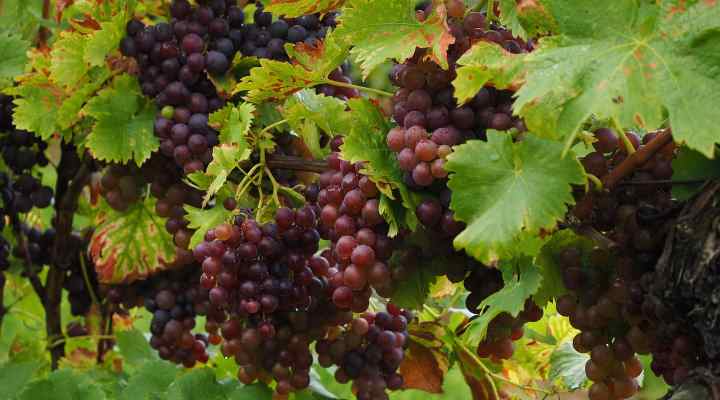
Grapes are deciduous, woody vines that produce clusters of juicy and sweet berries. The round to oval fruits grow in large bunches, with individual berries measuring 0.125” to 1” (3 – 25 mm) in diameter. Grape vines also produce edible, three-lobed green leaves. The woody fruit-producing stems grow up to 30 ft. (9 m) tall.
In the botanical sense, grapes are true berries. They develop from the ovary of a single flower and have fleshy pulp, thin skin, and one or more seeds inside.
Grapevines have long, climbing woody stems that scramble up fences, trellises, or over arbors and pergolas. The large green leaves are ideal for providing shade on hot summer days. Additionally, they have ornamental value when the foliage turns vibrant yellow, red, and purple shades in the fall.
Black Persimmon (Diospyros texana)

Black persimmon is a large multi-stemmed shrub that can grow as a tree. The sun-loving plant produces small black berries 0.6” to 1” (1.5 – 2.5 cm) in diameter. Apart from the round black berries, the shrub’s ornamental value comes from its glossy green leaves and urn-shaped white flowers that bloom in spring.
This drought-tolerant plant grows 10 to 15 ft. (3 – 4.5 m) tall. One of its most attractive features is the grayish-white bark that peels, revealing pink and white patches of underbark. Additionally, the black fruits add dramatic color to southern landscapes.
Native to Texas, the small fruiting shrub attracts pollinators and birds. Humans also enjoy the edible berries, using them to make custards, puddings, and juices.
Related articles:
- Pineberry: The White Strawberry that Tastes Like Pineapple
- Types of Red Berries That Grow on Trees or Shrubs
- Types of Fruits: List of Fruits with Their Picture and Name

